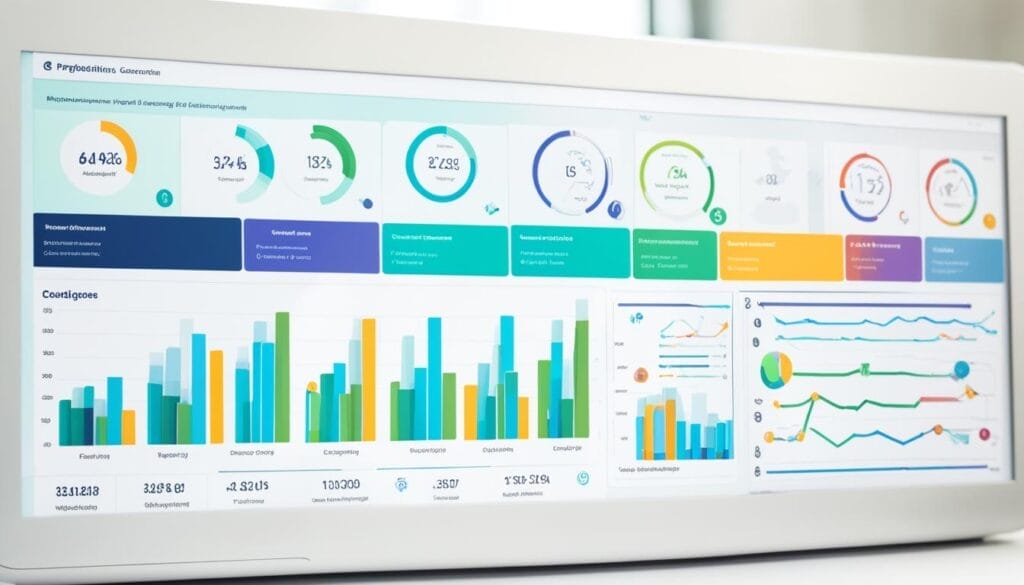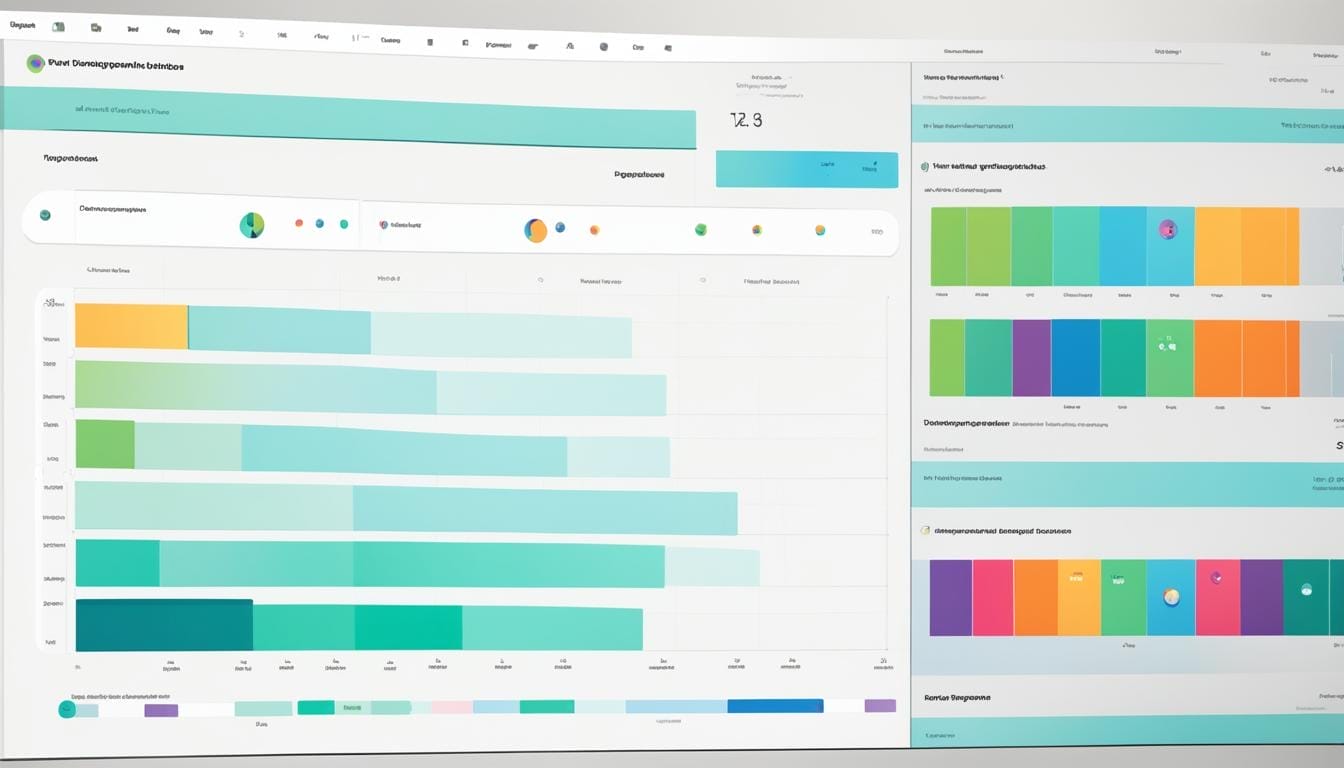Imagine a learning experience tailored specifically to your needs, where data-driven insights guide your educational journey. What if you had access to a personalized learning analytics dashboard that not only tracked your progress but also provided recommendations to help you succeed? In the era of digital innovation, personalized dashboards have emerged as powerful tools that harness the potential of data to transform education.
With a personalized learning analytics dashboard, you can harness the power of data-driven insights to unlock your full potential. By analyzing your individual learning progress and leveraging artificial intelligence (AI), this dashboard empowers you to make informed decisions that optimize your educational outcomes. Gone are the days of generic educational experiences – with a personalized dashboard, your learning journey becomes a tailored adventure filled with growth and success.
So, how does a personalized learning analytics dashboard work? What benefits does it offer to both educators and students? And what challenges need to be overcome to ensure its effective implementation? Join us as we delve into the fascinating world of personalized learning analytics dashboards and explore their impact on education.
Key Takeaways:
- Personalized learning analytics dashboards harness the power of data to enhance education.
- By tracking individual progress and providing data-driven recommendations, these dashboards optimize learning outcomes.
- Challenges in development, implementation, and effectiveness must be addressed for successful utilization of dashboards.
- There is a growing trend towards incorporating predictive analytics in learning dashboards.
- Engaging students and educators in the development process and allowing for customization is crucial for effective implementation.
The Importance of Learning Analytics Dashboards in Education
Learning analytics dashboards play a crucial role in education by providing educators and students with a comprehensive view of learning progress and performance metrics. These interactive dashboards enable students to track their own progress and make data-driven decisions, while also offering valuable insights to educators for identifying areas of improvement.
One of the key benefits of learning analytics dashboards is their ability to track and monitor progress. By providing real-time analytics and customizable visualizations, learners can easily track their performance and identify areas where they excel or may need additional support. This progress tracking feature enables students to take ownership of their learning journey and make informed decisions about their education.
Through the use of learning analytics dashboards, educators gain access to valuable insights into student learning. They can analyze performance trends, identify struggling students, and tailor instructional strategies to meet individual needs. By leveraging data-driven insights from the dashboard, teachers can provide targeted support and interventions, ultimately enhancing the learning experience for every student.
Additionally, learning analytics dashboards offer a learning analytics platform that promotes data-driven decision-making. With the ability to visualize and analyze data, educators can identify patterns and trends in student performance, enabling them to make informed decisions about curriculum, instruction, and intervention strategies. This data-driven approach empowers educators to adapt and personalize their teaching methods, optimizing student learning outcomes.
Learning analytics dashboards provide a powerful tool for progress tracking and data-driven decision-making. By utilizing these platforms, educators can tailor their instruction and support to meet the unique needs of each student, ultimately driving educational success.
Overall, learning analytics dashboards contribute to a more personalized and effective educational experience for both educators and students. By tracking progress, providing valuable insights, and promoting data-driven decision-making, these dashboards play a vital role in improving learning outcomes and empowering learners to achieve their full potential.
Key Features of Learning Analytics Dashboards
| Feature | Description |
|---|---|
| Progress Tracking | Real-time monitoring and visualization of learning progress |
| Data Visualization | Interactive and customizable visualizations for better understanding of performance |
| Data Analysis | Powerful analytics tools for identifying patterns and trends in student performance |
| Customization | Ability to tailor dashboards to individual learning goals and preferences |
| Intervention Insights | Data-driven insights for targeted interventions and support |
Student Perspectives on Learning Analytics Dashboards
When it comes to learning analytics dashboards, students have diverse preferences and attitudes. While some students appreciate the ability to track their progress and receive personalized feedback, others express concerns about privacy and potential surveillance. Understanding these student perspectives is crucial for designing and implementing effective learning analytics dashboards that cater to their needs and address their concerns.
The Value of Progress Tracking
“I find it extremely helpful to track my progress through a learning analytics dashboard. It gives me a clear overview of my strengths and weaknesses, allowing me to focus on areas that require improvement.” – Sarah Anderson, College Student
For many students like Sarah, the ability to track their progress is a valuable feature of learning analytics dashboards. It enables them to identify areas where they excel and areas where they need to put in more effort. This self-monitoring empowers students to take ownership of their learning journey and make informed decisions about their study strategies.
Personalization and Feedback
“Receiving personalized feedback through a learning analytics dashboard has been a game-changer for me. It helps me understand my strengths and weaknesses in depth and guides me towards targeted improvements.” – David Ramirez, High School Student
David, like many other students, values the personalized feedback generated by learning analytics dashboards. This feedback provides more than just surface-level insights; it offers specific recommendations for improvement based on individual learning data. By leveraging this personalized feedback, students can refine their study methods and make meaningful progress towards their academic goals.
Privacy Concerns
“I’m a bit skeptical about learning analytics dashboards because of privacy concerns. I worry that my every move will be monitored and analyzed, and it takes away some of the freedom and individuality in learning.” – Emily Johnson, University Student
Privacy is a significant concern for some students like Emily. They worry that learning analytics dashboards may infringe upon their privacy rights and compromise their autonomy as learners. Addressing these concerns through transparent data handling practices and clear communication about data usage can help alleviate student apprehension and build trust in the use of learning analytics dashboards.
Designing Student-Centric Dashboards
To create effective learning analytics dashboards that cater to student preferences and address privacy concerns, it is essential for educators and developers to actively involve students in the design process. Gathering feedback, conducting user testing, and incorporating student suggestions can ensure that the dashboards align with their needs and expectations.
Challenges in Developing and Implementing Learning Analytics Dashboards
Developing and implementing learning analytics dashboards pose various challenges that need to be addressed for successful deployment. These challenges revolve around dashboard development, operationalization, and data analysis in an educational context.
1. Dashboard Development
A key challenge in developing learning analytics dashboards is ensuring that they provide meaningful and actionable insights to users. This involves designing intuitive user interfaces that present data in a visually appealing and easily understandable format. Dashboards should offer customizable features, allowing users to focus on the specific metrics and visualizations that align with their needs.
2. Operationalization Challenges
Operationalizing learning analytics dashboards involves integrating them into the educational setting seamlessly. One of the challenges is ensuring the compatibility and interoperability of the dashboard with existing educational technologies and systems. This includes considerations such as data privacy, security, and user authentication protocols to protect sensitive student information.
“The successful operationalization of learning analytics dashboards requires careful planning and collaboration between educators, administrators, and technology experts,” states Dr. Lisa Johnson, a leading expert in educational analytics.
3. Data Analysis
The effective analysis of data within learning analytics dashboards is crucial for identifying actionable insights and driving informed decision-making. However, challenges arise in processing and analyzing large volumes of data generated by multiple users. Data cleaning, transformation, and visualization techniques need to be employed to extract meaningful patterns and trends.
“The challenge lies in finding the right balance between simplicity and depth in the data analysis process,” explains Dr. Mark Roberts, a data analyst specializing in educational settings.
To overcome these challenges, collaboration between educators, data scientists, and technology experts is necessary. By addressing these challenges, developers can create robust and user-friendly learning analytics dashboards that empower educators and students alike.
Current State of Practice in Learning Analytics Dashboards

Many learning analytics dashboards in use today predominantly employ descriptive analytics, providing surface-level insights into learning progress. However, the landscape is evolving as a growing trend emerges in the integration of predictive analytics. These analytics utilize current data patterns to forecast future outcomes, offering learners more valuable and actionable insights. The incorporation of predictive analytics in learning analytics dashboards empowers learners to make informed decisions and take proactive steps towards their educational goals.
While descriptive analytics offer initial insights into learning progress, predictive analytics take it a step further by providing learners with actionable recommendations based on future data projections. By leveraging the power of predictive analytics, learning analytics dashboards enable learners to anticipate challenges and tailor their learning strategies accordingly, resulting in more effective and efficient learning outcomes.
A recent study conducted by Second Source revealed the increasing adoption of predictive analytics in learning analytics dashboards. The study surveyed a diverse range of educational institutions and highlighted the positive impact of predictive analytics on learner engagement, satisfaction, and overall performance. With the ability to forecast future outcomes, learners can proactively address gaps in their knowledge, focus their efforts on areas of improvement, and enhance their overall learning experience.
| Descriptive Analytics | Predictive Analytics | |
|---|---|---|
| Insights | Offers surface-level insights into learning progress | Provides actionable recommendations based on future data projections |
| Benefits | Initial understanding of learning progress | Proactive decision-making for learners |
| Impact | Helps identify areas for improvement | Enhances learner engagement and performance |
This shift towards incorporating predictive analytics in learning analytics dashboards signifies a significant advancement in the field of education. By harnessing the power of data and predictive modeling, these dashboards equip learners with a new level of insight and decision-making capabilities. Learners are no longer solely reliant on historical data but are empowered to anticipate and shape their future learning journey.
The integration of predictive analytics in learning analytics dashboards opens up exciting possibilities for personalized and adaptive learning experiences. Learners can receive personalized recommendations based on their unique learning patterns, enabling them to optimize their efforts and achieve their academic goals more effectively.
As educational institutions continue to unlock the potential of predictive analytics in learning analytics dashboards, the future of education is set to witness even more transformative and data-driven approaches. By leveraging actionable insights and predictive capabilities, learning analytics dashboards are revolutionizing the way students learn, adapt, and succeed in an ever-evolving educational landscape.
Proposed State-of-the-Art Learning Analytics Dashboard
To address the limitations of current learning analytics dashboards, a state-of-the-art dashboard is proposed. This innovative dashboard goes beyond traditional descriptive analytics and integrates predictive and prescriptive analytics to provide learners with a comprehensive tool for optimizing their educational journey. By leveraging machine learning and data-driven insights, this proposed dashboard aims to maximize learning outcomes and support learners in achieving their educational goals.
The integration of predictive analytics allows the dashboard to forecast future outcomes based on current data patterns. By analyzing historical data and identifying trends, the dashboard can provide learners with valuable predictions and recommendations for their educational progress. This proactive approach empowers learners to make informed decisions and take actions that will positively impact their learning journey.
Furthermore, the incorporation of prescriptive analytics takes the dashboard to the next level by providing concrete advice and recommendations for behavioral changes. By analyzing learner data, the dashboard can identify areas where adjustments can be made to enhance performance and learning outcomes. These personalized recommendations guide learners towards more effective learning strategies and study habits, ultimately supporting their academic growth.
With the proposed state-of-the-art learning analytics dashboard, learners have access to a comprehensive tool that not only tracks their progress but also provides actionable insights and personalized recommendations for behavioral changes. By empowering learners with the right information at the right time, this dashboard aims to facilitate continuous improvement and drive positive behavioral changes that lead to enhanced learning outcomes.
Key Features of the Proposed State-of-the-Art Dashboard
- Integration of descriptive, predictive, and prescriptive analytics
- Real-time tracking of learning progress
- Forecasting future outcomes based on data patterns
- Personalized recommendations for behavioral changes
- Interactive visualizations for enhanced data understanding
“The proposed state-of-the-art learning analytics dashboard takes learner support to the next level by providing not only insights into past performance but also predictions and recommendations for future success. It empowers learners to take control of their learning journey and make informed decisions based on data.” – Education Expert
Challenges and Future Directions in Learning Analytics Dashboarding
Developing and implementing learning analytics dashboards in the education sector come with a range of challenges that need to be addressed for their effective use. These challenges include ensuring accurate representation and actionable insights, addressing ethical concerns, and maintaining agility in an ever-evolving educational landscape. Overcoming these challenges is crucial to unlock the full potential of learning analytics dashboards and harness their benefits for both students and educators.
Representation and Actions
A significant challenge in learning analytics dashboarding is ensuring that the data and insights presented are accurate representations of a student’s learning progress. The dashboard should provide meaningful and actionable insights that facilitate informed decision-making for both students and educators. This requires careful consideration of the data sources, algorithms, and visualizations used in the dashboard’s design to ensure the accuracy and relevance of the presented information.
Ethics
Ethical considerations are paramount in the development and implementation of learning analytics dashboards. Privacy concerns, data security, and responsible data use are critical aspects that need to be addressed to protect the rights and interests of students. Learning analytics dashboards should comply with relevant data protection regulations and prioritize transparency and informed consent. Safeguarding student data privacy and maintaining ethical practices are essential for building trust and ensuring the responsible use of analytics in education.
Agility
As the field of education continues to evolve, learning analytics dashboards must be agile and adaptable to meet changing needs and emerging frontiers. Educational institutions need dashboards that can integrate new technologies, accommodate evolving pedagogical approaches, and support innovative learning experiences. By embracing technological advancements and staying ahead of emerging trends, learning analytics dashboards can continue to provide valuable insights and drive positive educational outcomes.
“Learning analytics dashboards face challenges such as representation and actions, ethics, and agility.”
Future research in learning analytics dashboarding should focus on understanding students’ emotional and behavioral responses to feedback provided through these dashboards. This deeper understanding can inform the design and refinement of dashboards to better support student engagement and motivation. Additionally, exploring emerging frontiers such as augmented reality (AR), virtual reality (VR), and natural language processing (NLP) can open new possibilities for enriching learning analytics experiences.
Benefits and Effectiveness of Learning Analytics Dashboards
While evidence on the effectiveness of learning analytics dashboards is limited, there is potential for these dashboards to improve learning outcomes and support self-regulated learning. By providing students with insights into their learning progress and opportunities for reflection and adjustment, learning analytics dashboards have the potential to positively impact academic achievement.
Continued research and evaluation are needed to better understand the benefits and effectiveness of these dashboards.
Insights into Learning Progress
One of the key benefits of learning analytics dashboards is the ability to provide students with real-time insights into their learning progress. By analyzing data on their performance, engagement, and study habits, these dashboards can offer personalized recommendations for improvement and highlight areas of strength.
Opportunities for Reflection and Adjustment
Learning analytics dashboards also empower students to take ownership of their learning journey by providing opportunities for reflection and adjustment. Students can use the data and feedback provided by the dashboard to identify areas where they may need to modify their study strategies or seek additional support.
“Learning analytics dashboards have the potential to revolutionize the way students approach their studies. By providing real-time data and personalized insights, these dashboards empower students to become more proactive and engaged learners.”
By promoting self-regulated learning, where students actively monitor and regulate their learning strategies, learning analytics dashboards can contribute to improved academic performance and long-term success.
Supporting Educators
Learning analytics dashboards also offer valuable insights for educators. By providing a holistic view of student performance and engagement, these dashboards enable educators to identify trends, personalize instruction, and tailor interventions to meet the specific needs of their students.
Additionally, learning analytics dashboards can help educators measure the effectiveness of their teaching methods and make data-informed decisions to enhance instructional practices.
While learning analytics dashboards show promise in improving learning outcomes and supporting self-regulated learning, it is important to recognize the need for ongoing research, evaluation, and refinement to maximize their effectiveness and ensure ethical implementation.
Key Takeaways:
- Learning analytics dashboards have the potential to improve learning outcomes and support self-regulated learning.
- These dashboards provide insights into learning progress and opportunities for reflection and adjustment.
- They empower students to take ownership of their learning journey and promote proactive and engaged learning.
- Learning analytics dashboards also offer valuable insights for educators to personalize instruction and enhance teaching practices.
- Continued research and evaluation are necessary to optimize the benefits and effectiveness of learning analytics dashboards.
Implementing Personalized Learning Analytics Dashboards

Implementing personalized learning analytics dashboards requires careful consideration of effective implementation strategies that promote user engagement and customization. By engaging students and educators in the development process and allowing for customization of the dashboards, the level of user satisfaction and effectiveness can be significantly enhanced.
One strategy is to involve stakeholders in the design and development of the dashboards. By including students and educators in the decision-making process, their unique insights and preferences can be incorporated, resulting in a more user-centric and tailored experience. This collaborative approach fosters a sense of ownership and investment in the dashboards, increasing user engagement and enthusiasm for utilizing the analytics.
Customization is another key aspect of successful implementation. Providing users with the ability to customize their dashboards according to their individual needs and preferences allows them to access the information that is most relevant to them. This level of personalization not only enhances the user experience but also empowers users to take ownership of their learning journey.
Additionally, implementation should include comprehensive training and support for users. To ensure users can fully utilize the features and benefits of the personalized learning analytics dashboards, training sessions should be conducted to familiarize them with the interface and functionalities. Ongoing support should also be provided to address any queries or challenges that users may encounter, ensuring a seamless and empowering experience.
“By engaging students and educators in the development process and allowing for customization of the dashboards, the level of user satisfaction and effectiveness can be significantly enhanced.”
Ultimately, successful implementation of personalized learning analytics dashboards requires a holistic approach that prioritizes user engagement and customization. By incorporating input from stakeholders, offering customization options, and providing comprehensive training and support, educational institutions can ensure the seamless integration of these dashboards and maximize their potential in enhancing learning outcomes.”
Conclusion
In conclusion, personalized learning analytics dashboards have the potential to revolutionize education by providing valuable insights and data-driven recommendations for both students and educators. These dashboards leverage the power of data to enhance learning outcomes and drive educational success.
By tracking and analyzing individual learning progress, personalized learning analytics dashboards offer a comprehensive view of students’ strengths and areas for improvement. This data-driven approach allows for targeted interventions and personalized support, ultimately leading to improved academic performance.
However, it is important to address the challenges associated with the development, implementation, and effectiveness of learning analytics dashboards. Ensuring meaningful and actionable insights, addressing privacy concerns, and integrating these dashboards seamlessly into the educational setting are key areas that need attention.
In summary, personalized learning analytics dashboards hold immense promise in improving education. By harnessing the potential of data, these dashboards have the ability to shape teaching and learning practices, enhance student engagement, and foster self-regulated learning. It is crucial to continue researching and refining these dashboards to fully realize their benefits and unlock their transformative potential in education.
FAQ
What is a personalized learning analytics dashboard?
A personalized learning analytics dashboard is a powerful tool that utilizes data to enhance learning outcomes and drive educational success. It tracks and analyzes individual learning progress with AI and provides analytical insights and data-driven insights for data-driven decision making in education.
How do learning analytics dashboards benefit education?
Learning analytics dashboards play a crucial role in education by allowing educators and students to track learning progress and performance metrics. They provide real-time analytics and interactive visualizations, enabling students to monitor their own progress and make data-driven decisions. They also provide educators with valuable insights into student learning and help identify areas for improvement.
What are the student perspectives on learning analytics dashboards?
Students have varying preferences and attitudes towards learning analytics dashboards. Some appreciate the ability to track their progress and receive personalized feedback, while others have concerns about privacy and potential surveillance. Understanding student perspectives can help inform the design and implementation of effective learning analytics dashboards.
What are the challenges in developing and implementing learning analytics dashboards?
Developing and implementing learning analytics dashboards face challenges such as ensuring meaningful and actionable insights, addressing privacy concerns, and effectively integrating analytics tools into the educational setting. Overcoming these challenges is crucial for successful implementation and utilization of learning analytics dashboards.
What is the current state of practice in learning analytics dashboards?
Many learning analytics dashboards primarily employ descriptive analytics, providing surface-level insights into learning progress. However, there is a growing trend towards incorporating predictive analytics that can forecast future outcomes based on current data patterns. These predictive analytics offer more value and support informed decision-making for learners.
What is the proposed state-of-the-art learning analytics dashboard?
To address the limitations of current learning analytics dashboards, a state-of-the-art dashboard is proposed. This dashboard integrates descriptive, predictive, and prescriptive analytics, allowing learners to not only track their progress but also receive concrete advice and recommendations for behavioral changes. Its goal is to maximize learning outcomes and support learners in achieving their educational goals.
What are the challenges and future directions in learning analytics dashboarding?
The development and implementation of learning analytics dashboards face challenges such as representation and actions, ethics, and agility. Additionally, future research should focus on understanding students’ emotional and behavioral responses to learning analytics feedback and exploring emerging frontiers in dashboarding, including meeting emerging regulatory requirements.
What are the benefits and effectiveness of learning analytics dashboards?
While evidence on the effectiveness of learning analytics dashboards is limited, they have the potential to improve learning outcomes and support self-regulated learning. By providing students with insights into their learning progress and opportunities for reflection and adjustment, learning analytics dashboards can positively impact academic achievement. Continued research and evaluation are needed to better understand their benefits and effectiveness.
How can personalized learning analytics dashboards be implemented?
Successful implementation of personalized learning analytics dashboards involves considering implementation strategies that promote user engagement and customization. Engaging students and educators in the development process and allowing for customization of dashboards can enhance user satisfaction and effectiveness. Implementation should also include training and support to ensure users can fully utilize the features and benefits of the dashboards.




